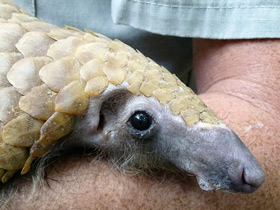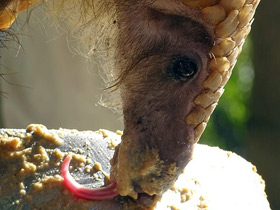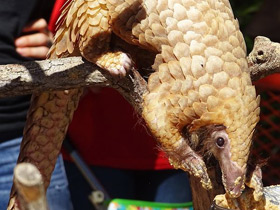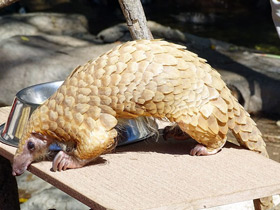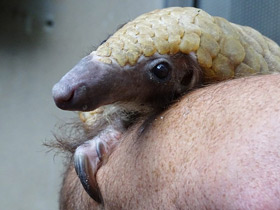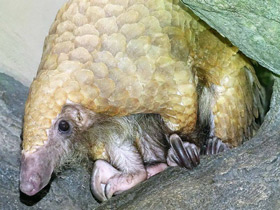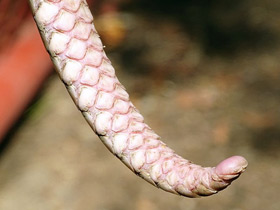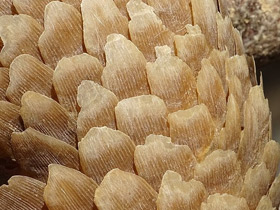The tree pangolin, white-bellied pangolin or three-cusped pangolin (Phataginus tricuspis)
The tree pangolin (Phataginus tricuspis) is one of eight extant species of pangolins ("scaly anteaters"), and is native to equatorial Africa. Also known as the white-bellied pangolin or three-cusped pangolin, it is the most common of the African forest pangolins.
Taxonomy
The tree pangolin had belonged to the genus Manis and subgenus Phataginus before Phataginus was elevated to generic status. Two subspecies were recognized in 1972 by Meester:
- Phataginus tricuspis tricuspis;
- Phataginus tricuspis mabirae (Uganda).
The tree pangolins, along with the Long-tailed pangolins, make up the genus Phataginus (the African Tree Pangolins). This makes Phataginus tetradactyla the closest relative to Phataginus tricuspis.
Description
Manis tricuspis is a species of folid mammal of the family Manidae. Manis tricuspis is the smallest species of Manis: body length is 37 to 44 cm, tail length 40 to 50 cm, weight varies from 1.8 to 2.4 kg. The top of the head, back, sides, outer surface of the limbs and tail of Manis tricuspis are covered with scales. They are brown to dark brown in colour.
Each scale has three well-defined dots on the loose margin (hence the origin of the species epithet tricuspis). In older animals, the dots fade.
Unlike other members of the genus, the scales of Manis tricuspis have spines, which are especially prominent on the dorsum.
Another characteristic of Manis tricuspis is its forty centimetre long tongue and enlarged salivary glands, which have a specific honey odour to attract termites and ants. The skin, visible on the unprotected abdomen, is white, which gave rise to the species name.
Habitat and lifestyle
The range of the species Manis tricuspis extends from Senegal to western Kenya and southern Zambia. The lizard inhabits humid lowland forests (primary and secondary), savannahs and cultivated land. It has a predominantly arboreal and nocturnal lifestyle.
Manis tricuspis is a good woodworm. The tip of its already tenacious and long tail lacks scales, which further increases its tenacity. During the day, lizards rest in hollow trees, among epiphytes and in excavated termites.
They are territorial animals. Each of the representatives of this species, irrespective of sex, lives a solitary life exclusively in its territory, with the female's surface area being about 40 km2 and the male's up to 200 km2. African lizards mark their territory with secretions from the anal region. Females rarely meet each other, as their territories do not overlap. The territories of males overlap with those of several females. Males and females meet regularly for short periods, especially when females are in oestrus.
Scientific behavioural fact
The Tree Pangolin is an intriguing organism characterized by a plethora of unique attributes. One notable characteristic that warrants scientific attention is the extraordinary armor-like scales possessed by these organisms. These scales serve a dual purpose, functioning as both a defensive barrier and an exceptional adaption.
The pangolins possess a complete covering of keratinous scales that are arranged in overlapping patterns, thus offering a highly efficient means of protection against potential dangers. The scales of the pangolin exhibit exceptional durability, resulting in a high level of resistance against the majority of predators. When confronted with a perilous situation, the Tree Pangolin possesses the ability to contort its body into a compact form, rendering it very resistant to penetration. This defence mechanism is facilitated by the utilization of its scales, which function as an impenetrable shield. The aforementioned behavioral traits have resulted in the colloquial moniker "scaly anteaters" being attributed to them.
Nutrition
Like all Manidae, Manis tricuspis feeds on ants, termites and other invertebrates, grasping prey with its long, sticky tongue. As it has no teeth, its prey is crushed by its stomach. It clings to branches with its hind legs and tail, and breaks insect structures with its front legs. It feeds on terrestrial and wood termites, as well as ants of the genus Crematogaster, which it finds thanks to its acute sense of smell. However, like other lizards, it prefers certain types of ants and termites, and is completely alien to others.
Reproduction
The gestation period of Manis tricuspis lasts about 150 days, after which the females give birth to a young, which they carry at the base of their tail. The newborn weighs between 90 and 160 grams and its scutes are soft, beginning to harden in the first few days of life. When threatened, females curl around their young, which also curl into a ball. The young remain with their mother for five months. At least in zoos, females may take in other cubs for fostering.
Use by humans
The tree pangolin is subject to widespread and often intensive exploitation for bushmeat and traditional medicine, and is by far the most common of the pangolins found in African bushmeat markets. Conservationists believe this species underwent a decline of 20–25% between 1993 and 2008 (three pangolin generations) due mainly to the impact of the bushmeat hunting. They assert it continues to be harvested at unsustainable levels in some of its range. Its conservation status has been progressively elevated over time, from "Least Concern" in 1996 to "Endangered" by 2019.

















